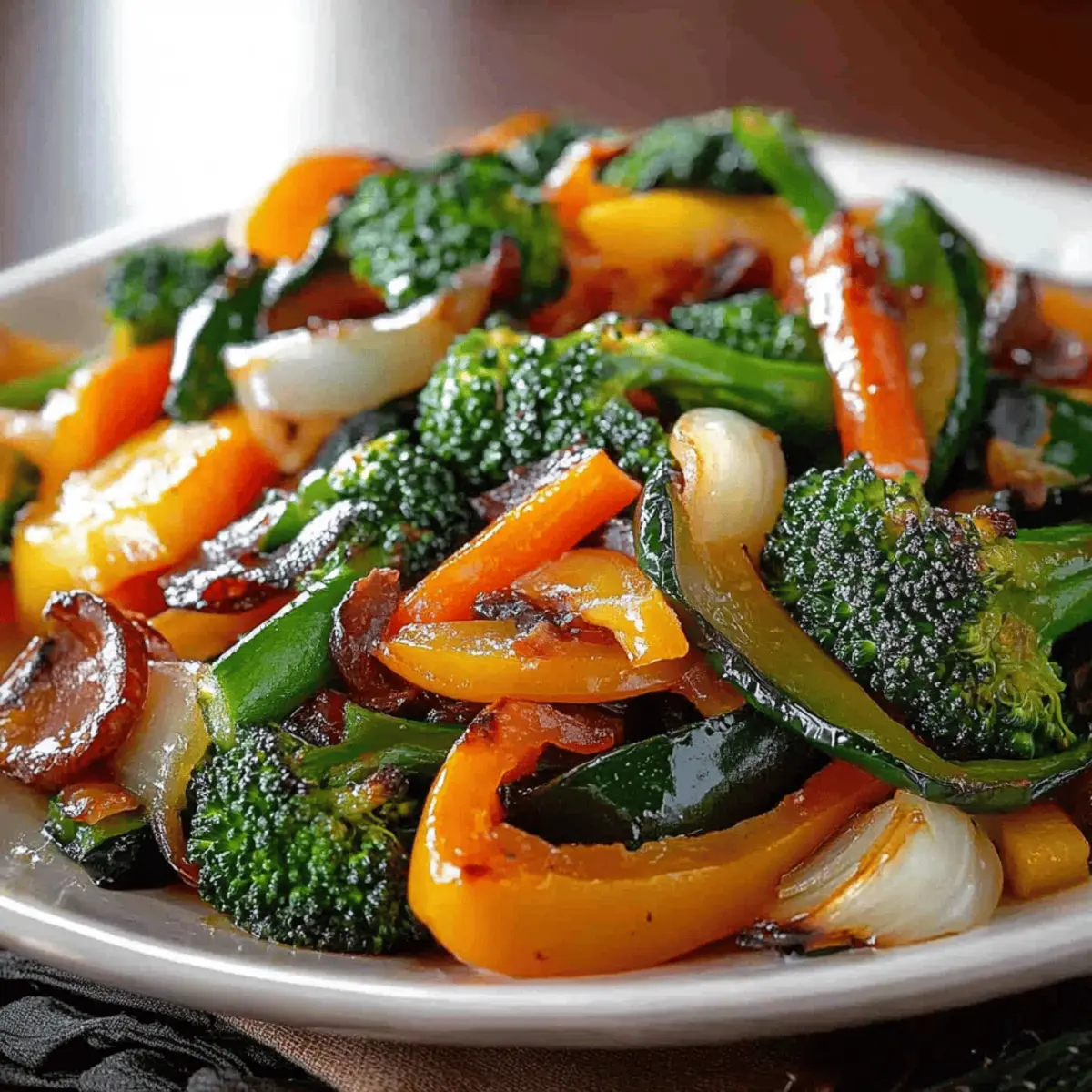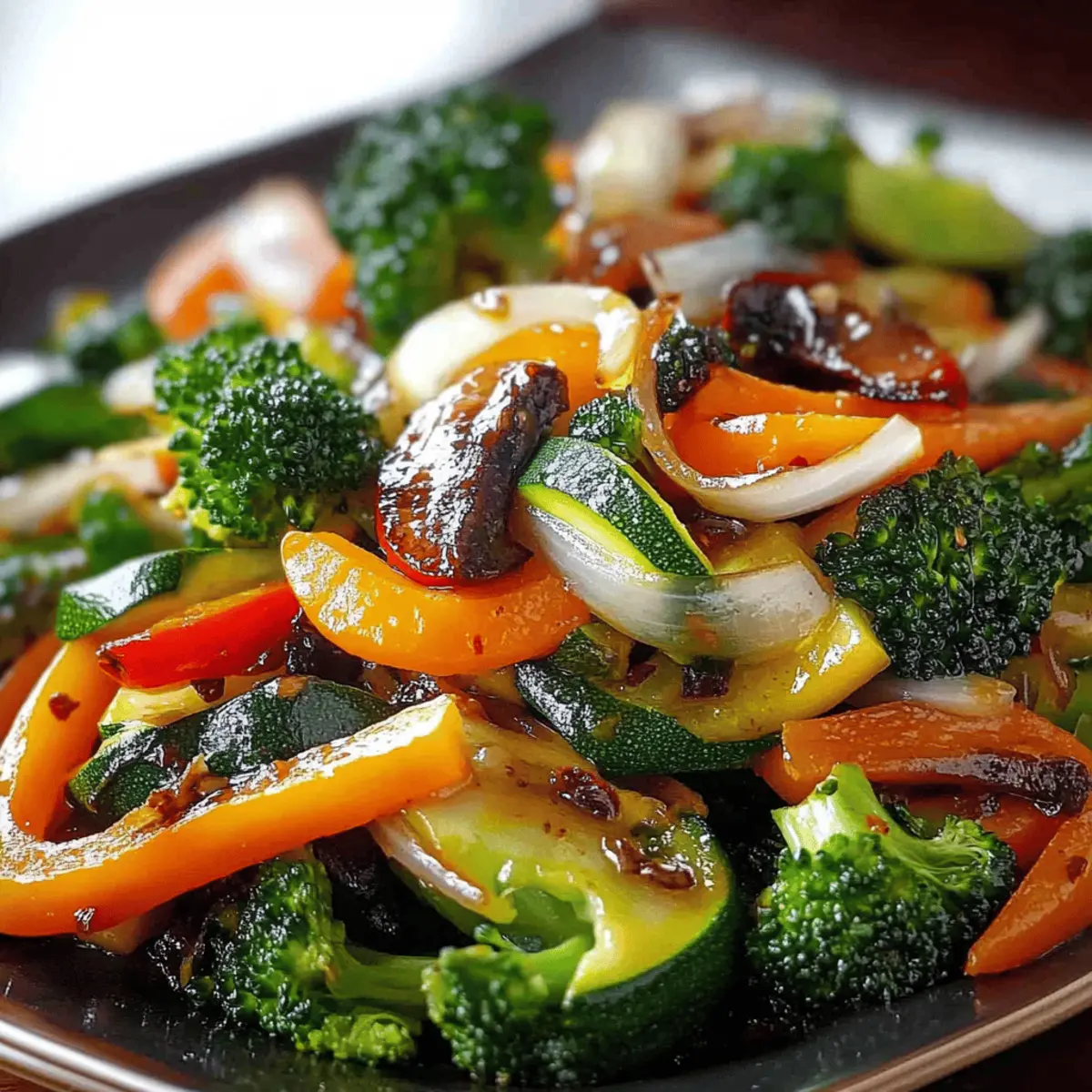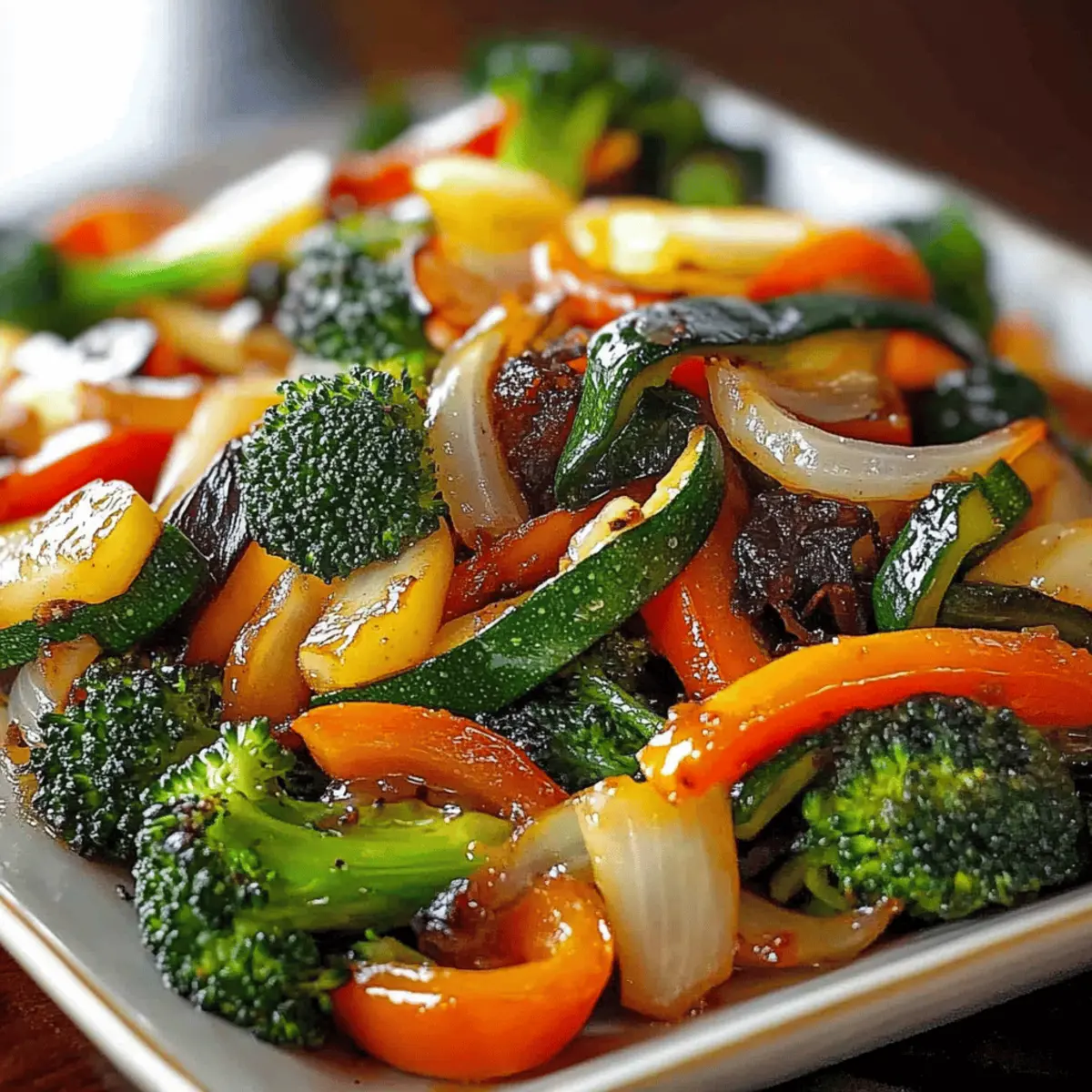As I stood in my kitchen, the vibrant colors of fresh produce caught my eye—crimson bell peppers, deep green zucchini, and sunny yellow carrots, all ready to dance in a hot skillet. It’s amazing how a simple technique like sautéing can transform these Healthy Sautéed Vegetables into a quick side dish that’s not only nutritious but full of life. This method highlights the natural sweetness of the veggies while keeping that delightful crunch, making it perfect for those busy weeknights or meal prep days. With endless variations at your fingertips—think Garlic-Parmesan or Mediterranean flair—these colorful vegetables not only brighten your plate but also your mood. So why settle for takeout when you can whip up something nourishing and delicious in no time? Are you ready to elevate your veggie game? Let’s get started!

Why are colorful vegetables so appealing?
Vibrancy makes this dish visually stunning—think of the rainbow of colors that makes your plate pop! Flavor-packed and aromatic, these Healthy Sautéed Vegetables infuse any meal with delightful taste while remaining low in calories. Versatile variations allow you to switch it up with options like Asian-Inspired or Garlic-Parmesan, ensuring there’s something for everyone. Perfect for quick meal prep, you can whip up a batch in no time, making dinnertime a breeze. Plus, the nutritional benefits are unbeatable, providing essential vitamins and fiber to fuel your day. So, let’s put that flavor and color front and center on your dinner table!
Healthy Sautéed Vegetables Ingredients
For the Base:
- Olive oil (or avocado oil/butter) – Acts as the cooking medium and flavor carrier; feel free to substitute with any high smoke point oil.
- Garlic – Adds aromatic flavor; fresh minced garlic or garlic powder works well as alternatives.
- Onion – Provides sweetness and depth; shallots can be used for a milder taste.
Vegetable Medley:
- Bell pepper – Contributes color and crunch; any color works perfectly, or use other stir-fry vegetables as a substitute.
- Zucchini – Offers a tender texture; feel free to swap with other summer squash varieties.
- Broccoli – Adds texture and nutrients; cauliflower is a great substitute if you want a different flavor profile.
- Carrot – Provides sweetness and crunch; other root vegetables like parsnips can change it up.
- Snap peas – Contributes crispness; green beans or snow peas can be used as replacements.
- Mushrooms – Adds umami depth; use any variety such as button, shiitake, or portobello.
Seasoning and Extras:
- Salt and black pepper – Essential for flavor enhancement; adjust to your taste preference.
- Lemon juice (optional) – Brightens flavor; lime juice or a splash of vinegar can be substituted if desired.
- Balsamic vinegar or soy sauce (optional) – Adds depth and a touch of sweetness; tamari works for a gluten-free option.
- Optional toppings – Toasted nuts, seeds, or grated Parmesan can add delightful texture and flavor; perfect for customizing your Healthy Sautéed Vegetables!
Step‑by‑Step Instructions for Healthy Sautéed Vegetables
Step 1: Prep Vegetables
Begin by thoroughly washing all the vegetables under running water. Peel the carrots and zucchini as necessary, then chop everything into uniform pieces, about 1-inch in size. This ensures even cooking throughout your Healthy Sautéed Vegetables. Set them aside so that they’re ready to pop into the pan when it’s time to sauté.
Step 2: Heat Pan
Place a large skillet on the stove over medium-high heat and allow it to warm up for about 2 minutes. Once hot, add 1-2 tablespoons of olive oil or your choice of cooking oil. Swirl to coat the pan evenly, and watch for the oil to shimmer, indicating it’s hot enough to start cooking.
Step 3: Cook Aromatics
Add minced garlic and chopped onions to the skillet, sautéing them for 1-2 minutes until the onions become translucent and fragrant. Stir constantly to prevent burning, ensuring that the delightful aromas fill your kitchen. This sets a flavorful foundation for your Healthy Sautéed Vegetables.
Step 4: Add Harder Vegetables
Next, introduce the chopped carrots and broccoli into the pan, stirring well to combine with the aromatics. Cook for about 3-4 minutes, stirring frequently until the broccoli turns bright green and the carrots begin to soften. This step lays the groundwork for your veggie medley with hearty textures.
Step 5: Add Softer Vegetables
Now it’s time to mix in the bell peppers, zucchini, mushrooms, and snap peas. Stir everything together and sauté for an additional 4-5 minutes until the vegetables are crisp-tender and vibrant. You’ll know they’re ready when they look brightly colored and maintain a slight crunch, enhancing the appeal of your Healthy Sautéed Vegetables.
Step 6: Season
Sprinkle salt and black pepper over the sautéed vegetables, adjusting to your taste. If you’d like to elevate the flavor, drizzle in some optional lemon juice or balsamic vinegar at this point. Toss everything in the pan thoroughly to ensure the seasoning is evenly distributed and allows the flavors to meld beautifully.
Step 7: Finish & Serve
Remove the skillet from heat, and transfer your colorful Healthy Sautéed Vegetables to a serving dish. If desired, garnish with freshly chopped herbs, toasted nuts, seeds, or a sprinkle of grated Parmesan for added texture and flavor. Serve immediately, allowing the vibrant, sautéed veggies to shine on your dinner table.

What to Serve with Healthy Sautéed Vegetables
Looking to create a delightful meal that harmonizes perfectly with your colorful medley of sautéed veggies?
- Grilled Chicken: Juicy, seasoned chicken pairs beautifully, adding protein to balance the freshness of the vegetables.
- Quinoa Salad: A light quinoa salad with herbs and citrus dressing complements the flavors, enhancing the bright notes of your sautéed veggies.
- Lemon Herb Tofu: Marinated, pan-fried tofu delivers a satisfying texture and zesty taste that elevates your veggie dish and keeps it plant-based.
- Garlic Bread: Serve with warm, crusty garlic bread for a comforting touch. It’s perfect for soaking up any juices left on the plate.
- Pasta Primavera: Tossed with olive oil and herbs, this pasta dish echoes the freshness of your healthy sautéed vegetables while adding a comforting element.
- Red Wine: A glass of light-bodied red wine accentuates the earthy tones found in the sautéed mushrooms and adds a touch of warmth to the meal.
- Coconut Rice: Elevate your dish with fragrant coconut rice, complementing the vegetable medley with creamy texture and subtle sweetness.
- Fruit Sorbet: Round off the meal with a refreshing fruit sorbet for dessert; its fruity brightness echoes the vibrant flavors of your sautéed vegetables.
- Hummus and Pita: Serve a side of creamy hummus with warm pita. The dip provides richness while the veggies add crunch, creating a delightful contrast.
- Mixed Green Salad: A simple mixed green salad with a zesty vinaigrette rounds out the meal, offering freshness and crunch to balance the sautéed veggies.
Expert Tips for Healthy Sautéed Vegetables
-
Uniform Cutting: Ensuring all vegetables are cut to similar sizes helps them cook evenly, preventing some from being crunchy while others are mushy.
-
Avoid Overcrowding: Cook vegetables in batches if needed. Overcrowding the pan can lead to steaming rather than sautéing, which hinders those lovely caramelized flavors.
-
High Heat Cooking: Use medium-high heat to achieve that perfect sauté. This keeps the colors vibrant and the vegetables crisp-tender, making your Healthy Sautéed Vegetables a feast for the eyes and the palate.
-
Finish with Freshness: Add a sprinkle of fresh herbs or a splash of lemon juice right before serving. This brightens flavors and enhances the appeal of your dish.
-
Meal Prep Magic: Prepare chopped vegetables in advance; store them in airtight containers. When you’re ready, it makes whipping up your Healthy Sautéed Vegetables a breeze!
Make Ahead Options
These Healthy Sautéed Vegetables are perfect for anyone looking to save time during busy weeknights! You can prep all your vegetables (wash, peel, and chop) and store them in an airtight container in the refrigerator for up to 3 days. This way, they’re ready to sauté whenever you need them. To maintain their vibrant colors and freshness, try to chop vegetables uniformly. When it’s time to cook, simply heat 1-2 tablespoons of oil in a skillet, toss in your prepped veggies, and follow the remaining cooking steps for a quick, nutritious side dish. You’ll enjoy the same delicious flavors while making meal prep a breeze!
How to Store and Freeze Healthy Sautéed Vegetables
Fridge: Store leftovers in an airtight container for up to 3-4 days. This helps preserve the flavors and crispness of your Healthy Sautéed Vegetables for quick meals.
Freezer: For long-term storage, freeze your sautéed vegetables in a single layer on a baking sheet before transferring to a freezer bag. They can last up to 3 months; just thaw and reheat when needed.
Reheating: To maintain their texture, reheat your Healthy Sautéed Vegetables in a skillet over medium heat for a few minutes, or gently microwave them in short intervals, stirring in between.
Room Temperature: Avoid leaving sautéed vegetables out at room temperature for more than 2 hours to prevent spoilage and maintain food safety.
Healthy Sautéed Vegetables – Explore Variations!
Feel free to get creative with this recipe and make it your own, ensuring that each bite is uniquely delicious.
-
Garlic-Parmesan: Toss in minced garlic and finish with freshly grated Parmesan for a savory, cheesy touch that warms the soul.
-
Asian-Inspired: Incorporate soy sauce, sesame oil, and a sprinkle of sesame seeds to bring a delightful twist to your veggie mix. You’ll be amazed at how these flavors blend together beautifully.
-
Mediterranean: Drizzle with olive oil, add a hint of lemon zest, and finish with crumbled feta cheese for a refreshing burst of flavor that transports you to the sunny Mediterranean coast.
-
Spicy Kick: If you’re craving heat, just add chili flakes or your favorite hot sauce. The fiery flavors will awaken your taste buds and bring an exciting zing to your plate.
-
Colorful Mix: Experiment by adding seasonal vegetables. Think asparagus in spring or roasted butternut squash in the fall—each season brings new flavor opportunities.
-
Herby Delight: Enhance the freshness by adding herbs such as basil, oregano, or parsley just before serving. This simple step elevates the flavors and adds delightful complexity.
-
Nutty Addition: For delightful crunch, consider tossing in some toasted almonds or pine nuts. They not only add texture but also some heart-healthy fats.
-
Creamy Twist: Whip up a quick sauce with tahini or yogurt mixed with herbs and drizzle it over your sautéed veggies for a creamy, indulgent finish. It’s a perfect contrast to the crisp-tender veggies.
Transforming your Healthy Sautéed Vegetables is just a few substitutions away. Try pairing with a protein like grilled to chicken or tofu for a wholesome meal, or serve alongside grain bowls topped with your choice of quinoa or farro for extra nutrients. The options are endless!

Healthy Sautéed Vegetables Recipe FAQs
What should I look for when selecting vegetables?
Absolutely! When choosing vegetables for your Healthy Sautéed Vegetables, look for those that are vibrant in color and free from blemishes. For example, pick bell peppers that are firm and glossy, while zucchini should feel heavy for its size. Avoid any that have dark spots or are overly soft, as they may indicate spoilage.
How do I store leftovers of the sautéed vegetables?
You’ll want to store your Healthy Sautéed Vegetables in an airtight container in the fridge. This will keep them fresh for up to 3-4 days. When you’re ready to enjoy them, simply reheat in a skillet over medium heat for a few minutes to maintain their delightful texture.
Can I freeze sautéed vegetables, and if so, how?
Very! To freeze your Healthy Sautéed Vegetables, first, allow them to cool completely. Spread them in a single layer on a baking sheet to freeze individually, then transfer them to a resealable freezer bag. Storing them this way helps prevent clumping. They can be frozen for up to 3 months. When you’re ready to use them, thaw overnight in the fridge or sauté from frozen in a hot pan.
What if my vegetables are overcooked or mushy?
No worries; we’ve all been there! If your vegetables are overcooked, the key is to lower the cooking time next time and ensure that the heat remains high enough for sautéing. Stick to a cooking time shown in the recipe and keep an eye on the veggies to maintain that lovely crisp-tender texture.
Are there any dietary considerations I should keep in mind?
For sure! This Healthy Sautéed Vegetables recipe is vegan and vegetarian-friendly. If you or someone you’re serving has allergies, be mindful of add-ins like soy sauce (gluten) or nuts if you plan to use them as toppings. Always read labels and choose substitutes that align with dietary needs.
What optional ingredients can enhance the flavor of my sautéed vegetables?
Absolutely! You can brighten the flavors of your Healthy Sautéed Vegetables by incorporating a splash of lemon juice or balsamic vinegar at the end of cooking. Adding herbs like basil or parsley can also elevate the dish’s freshness and depth. Feel free to experiment with spices and toppings for your ideal flavor profile!

Vibrant Healthy Sautéed Vegetables for Quick, Delicious Meals
Ingredients
Equipment
Method
- Begin by thoroughly washing all the vegetables under running water. Peel the carrots and zucchini as necessary, then chop everything into uniform pieces, about 1-inch in size.
- Place a large skillet on the stove over medium-high heat and warm it up for about 2 minutes. Add 1-2 tablespoons of olive oil and swirl to coat the pan.
- Add minced garlic and chopped onions to the skillet, sautéing for 1-2 minutes until the onions become translucent.
- Introduce chopped carrots and broccoli into the pan, cooking for about 3-4 minutes, stirring frequently until bright green.
- Mix in bell peppers, zucchini, mushrooms, and snap peas. Sauté for an additional 4-5 minutes until crisp-tender.
- Sprinkle salt and black pepper over the sautéed vegetables, adjusting to your taste. Drizzle in lemon juice or balsamic vinegar if desired.
- Remove skillet from heat, transfer vegetables to a serving dish, and garnish with herbs, nuts, seeds, or Parmesan if desired.

Leave a Reply